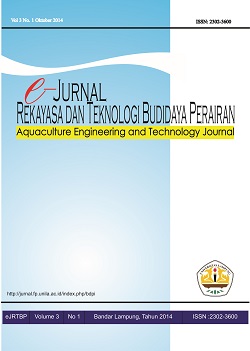Perbandingan Karbon dan Nitrogen pada Sistem Bioflok Terhadap Pertumbuhan Nila Merah (Oreochromis Niloticus)
Abstract
Nila merah (Oreochromis niloticus) merupakan salah satu komoditas perikanan di Indonesia yang memiliki nilai ekonomi tinggi. Berkembangnya proses budidaya nila merah juga berpengaruh terhadap peningkatan limbah diperairan.Salah satu cara untukmembantumengatasi limbah perairan dan dapat dimanfaatkan oleh ikan yaitu dengan sistem bioflok.Teknologi bioflok merupakan salah satu alternatif dalam mengatasi masalah kualitas air dalam akuakultur dan dimanfaatkan sebagai sumber pakan tambahan untuk nila merah.Tujuan penelitian ini adalah untuk menganalisis pertumbuhan dan tingkat kelangsungan hidup nila merah pada sistem bioflok dengan rasio C:N (perbandingan karbon dan nitrogen) yang berbeda.Rancangan penelitian yang digunakan adalah rancangan acak lengkap dengan empat perlakuan dan tiga kali ulangan. Perlakuan yang diuji yaitu (A) kontrol, (B) rasio C:N 15, (C) rasio C:N 20, (D) rasio C:N 25. Penelitian dilakukan dengan menggunakan benih nila merah dengan panjang total 3 cm dan berat rata-rata 2 ± 0,4 gramyang dipelihara dengan akuarium berukuran40x30x35 cm. Parameter penelitian meliputipertumbuhan mutlak, laju pertumbuhan spesifik, kelangsungan hidup, Feed Convertion Ratio (FCR), Protein Efficiency Ratio (PER), dan kualitas air.Hasil penelitian menunjukan bahwa rasio C:N yang berbeda pada aplikasi bioflok memberikan pengaruh terhadap pertumbuhan dan kelangsungan hidup nila merah. Kisaran laju pertumbuhan spesifik nila merah sebesar 12,17-16,33% dan tingkat kelangsungan hidup ikan nila 53,33-80%. Hasil pengukuran kualitas air untuk suhu pada pagi dan sore berkisar 26-27°C, pH relatif stabil pada 6-7 dan kandungan amonia setiap perlakuan terjadi peningkatan di akhir penelitian. Perlakuan terbaik adalah perlakuan B dengan rasio C:N 15.
Downloads
Downloads
Published
How to Cite
Issue
Section
License
License for Authors
Authors who publish with this journal agree to the following terms:
- Authors retain copyright and grant the journal right of first publication with the work simultaneously licensed under a Creative Commons Attribution-ShareAlike 4.0 International License that allows others to share the work with an acknowledgement of the work's authorship and initial publication in this journal.
- Authors are able to enter into separate, additional contractual arrangements for the non-exclusive distribution of the journal's published version of the work (e.g., post it to an institutional repository or publish it in a book), with an acknowledgement of its initial publication in this journal.
- Authors are permitted and encouraged to post their work online (e.g., in institutional repositories or on their website) prior to and during the submission process, as it can lead to productive exchanges, as well as earlier and greater citation of published work (See The Effect of Open Access).
- The Author warrant that this article is original and that the author has full power to publish. The author sign for and accepts responsibility for releasing this material on behalf of any and all-author. If the article based on or part of student’s thesis, the student needs to sign as his/her agreement that his/her works is going published.
License for Regular Users
Other regular users who want to cite, distribute, remix, tweak, and build upon author’s works, even for commercial purposes, should acknowledge the work’s authorship and initial publication in this journal, licensed under a Creative Commons Attribution-ShareAlike 4.0 International License.
This license lets others distribute, remix, tweak, and build upon your work, even commercially, as long as they credit you for the original creation.

This work is licensed under a Creative Commons Attribution-ShareAlike 4.0 International License.





















